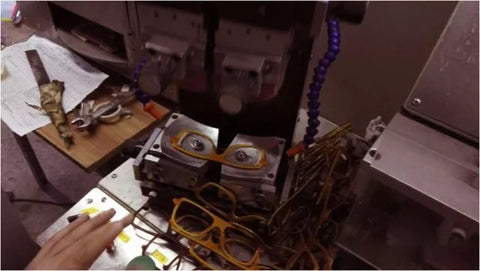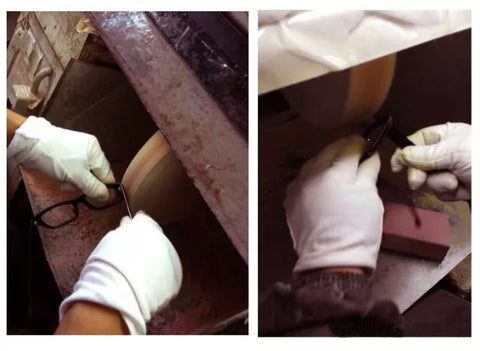Craftsmanship: How the Original Glasses Are Made
Craftsmanship: How the Original Glasses Are Made
When we see a pair of glasses, we tend to think that the simple structure isn’t too complicated to be made. However, just one pair of glasses, from design to production, goes through hundreds of procedures, eventually becoming the elegant masterpiece lying on the bridge of our noses.
Today,
we wanted to introduce
how the original glasses are made.
We are going to skip over the preliminary designing procedures, and mainly introduce the manufacturing procedures of the production processes.
① Plastic Frame
Cutting Ring Materials
Cut the ring material directly into a square. Using the template as a reference, make the cut 4 mm wider, and length 8 mm longer. The bending stake curves the rings, and lengthens it by 6mm.

Plastic Dryer
Put the cut materials into the oven and let dry for 72 hours, furnace temperature controlled at 62-65 degrees Celsius. The cut materials before processing will be shrunk with infrared rays. This is to prevent shrinkage at a later stage.

The Inner Ring, Outer Ring, and Frame Design

The inner ring, outer ring, and frame designs are completed at once by CNC (Computer Numerical Control) and is sent for handcraft.

Restructuring of Ring Materials
After going through rough rolling and mid-rolling, the ring frame material is entered into a small oven to soften, making it easy for restructuring. It must be noted that it cannot be put in the oven for too long, otherwise it would blister.
② Glue
Inserting Pin and Removing Extra Glue
After the pins are put in place, use a cutter blade to remove the glue overflowing on both sides of the hinge by hand, and be very careful not to leave marks on the hinge.
Extra Materials
The glue and eyeglass temples need to be assembled and processed according to their structure or size, and then extra materials are thrown away.

Structuring the Tail
The eyeglass tail is bent at an angle where the curvature and length are based on the drawing requirements.

Levigation
When glue is set with pins, you need to polish with a waterstone to ensure that the surface is smooth without protuberance.

③ Assembly
Peg Hinges
Peg the metal hinge into the front ring. Remember that the hinge can be electroplated but not glued.
Assembly
Align the hinge screws and assemble the front frame with the glue.

Polishing
When the eyeglass frames come out of the roller and assembled, scratches will be naturally made, some parts even with hard spots. Polishing can get rid of these scratches and hard spots, and to the greatest extent boost its shine.

④ Packaging
Lens Cutting
When cutting polaroid and presbyopia lenses, in addition to matching the spectacles to the frame, the parameters also need to be checked if the requirements are correct. As for the plain lenses, it only needs to be matched to the frame.

Labeling
Printed labeling needs to be clear, complete, neat and shouldn’t easily come off.
With the above complex manufacturing processes, can you see why the manufacturers of eyeglasses can be named "craftsmen", and their finished eyeglasses can be treated as works of art?😎
